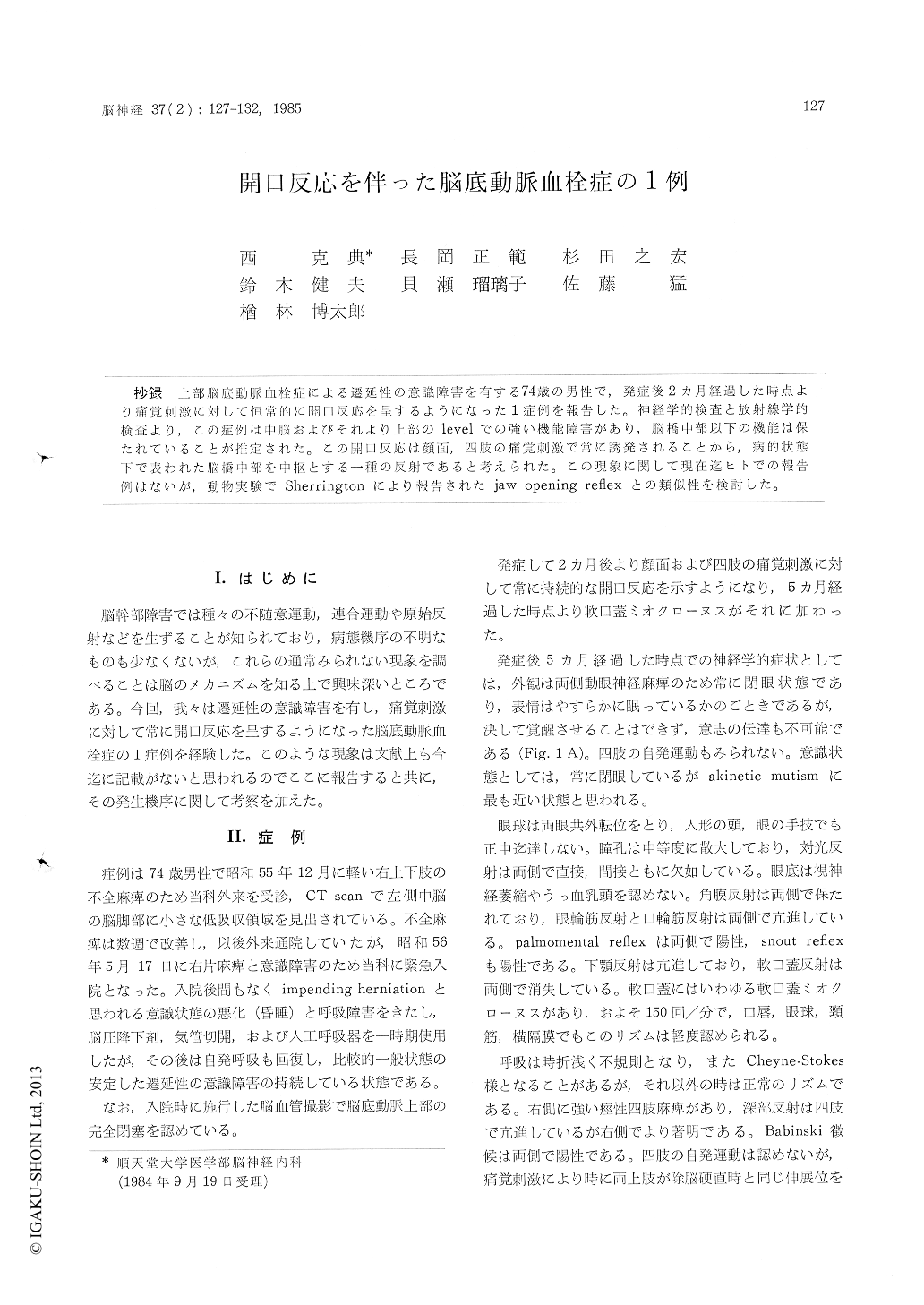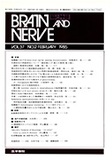Japanese
English
- 有料閲覧
- Abstract 文献概要
- 1ページ目 Look Inside
抄録 上部脳底動脈血栓症による遷延性の意識障害を有する74歳の男性で,発症後2ヵ月経過した時点より痛覚刺激に対して恒常的に開口反応を呈するようになった1症例を報告した。神経学的検査と放射線学的検査より,この症例は中脳およびそれより上部のlevelでの強い機能障害があり,脳橋中部以下の機能は保たれていることが推定された。この開口反応は顔面,四肢の痛覚刺激で常に誘発されることから,病的状態下で表われた脳橋中部を中枢とする一種の反射であると考えられた。この現象に関して現在迄ヒトでの報告例はないが,動物実験でSherringtonにより報告されたjaw opening refiexとの類似性を検討した。
We describe a 74 year old man who showed the jaw opening phenomenon by painful stimuli from two months after the onset of basilar artery throm-bosis. He was admitted to our hospital because of consciousness disturbance and paralysis of all extremities. Soon after admission, he was in a state of impending herniation but with conservative therapy he recovered slightly, and then fell into an akinetic and mute state.
Two months after the onset of the stroke, he began to open his mouth in response to painful stimuli, and five months after the stroke palatal myo-clonus also appeared. Neurological signs and symp-toms five months after admission were as follows: he was akinetic, mute and always kept his eyes closed because of complete blepharoptosis due to oculomotor nerve palsy. Pupils were dilated and adducted. Bilateral light reflexes were absent and the oculocepharic reflex could not adduct the eyes inwardly. Bilateral corneal reflexes were present, facial reflexes were exaggerated and jaw reflexes were also active. All limbs were spastic and paraly-zed, and no voluntary movement was observed. Deep tendon reflexes were active in all extremi-ties, and bilateral plantar responses were exten-sor. Palatal myoclonus was recognized in his soft palate, lips, sternocleidomastoid and diaphragm. Its frequncy was about 150 cycles per minute. CT scan revealed severe low density areas in the midbrain and bilateral posterior lobes. In cerebral angiography, the upper part of the basilar artery was completely occluded. No significant response was obtained either by sensory evoked response or by auditory brainstem evoked response. Latency of the first components of the blink reflex was bilaterally normal.
These results suggest that the most severely affected region was above the midbrain level, and function of the lower brain stem below the mid-pons seemed relatively well preserved.
In this patient jaw opening could be elicited from any part of the body by painful stimulation, and no other kind of stimuli could provoke this phenomenon. With painful stimuli, only tonic jaw opening with slight protrusion of tongue was observed and sometimes slight extensor response of the upper limbs was associated with it, but no other response such as grimacing or crying was seen. With electrical stimulation of first branch of trigeminal nerve and median nerve, more than supramaximal stimulation was required to provoke maximal M wave response to trigger this pheno-menon, and this suggested that the nerve fibers mediating this response were very small in dia-meter. This strange phenomenon has not been described previously, and we assumed that thismight be a kind of pathogical reflex under a chro-nically decerebrated state at the level of the mid-brain. The state of this patient resembled that of chronic cerveau isole in experimental animals, andresemblance to the jaw opening reflex, which was first reported by Sherrington, is discussed.

Copyright © 1985, Igaku-Shoin Ltd. All rights reserved.


